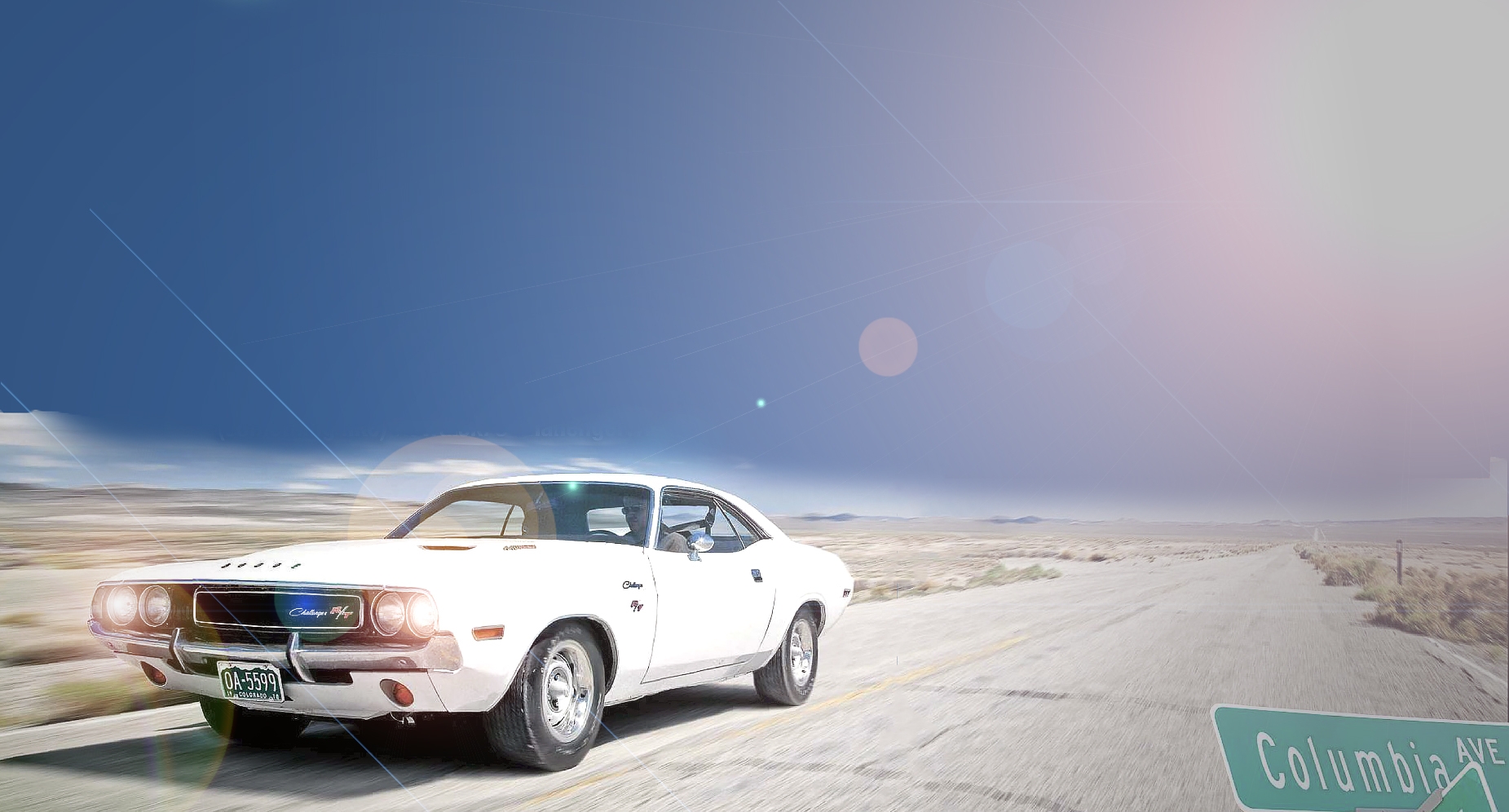
Returning to Vanishing Point. We celebrate probably the greatest American road movie ever while assaulting the Nevada desert in something like Kowalski’s Dodge Challenger R/T 440. 1971 – “It was the best of times, it was the worst of times,” as Charles Dickens wrote. It was the era which had just witnessed Woodstock, the first moon landing, the explosive growth of the civil rights movement, and the assassinations of Bobby Kennedy and Martin Luther King Jr. It was also an odd time in the history of film. The Beatles – a rock group – had been making movies. Best Picture Oscar nominees that year included A Clockwork Orange, Fiddler on the Roof, The Last Picture Show, The French Connection and Nicholas and Alexandra, with Connection taking home the big prize.
Several of these films became instant cult classics and remain so today. Social unrest underpinned much of the tension that permeated American society, with the silent majority still learning to cope with racial equality, hippies, drug culture and free love, and the women’s movement.
Car chase movies were nothing new; perhaps the best ever, Steve McQueen’s Bullitt, was but a few years old. And another classic automotive action scene – the race for time between officer Popeye Doyle’s battered Pontiac and a Brooklyn ‘N’ train – was among the centrepieces of The French Connection. Director Richard C Serafian insists his Vanishing Point, release in 1971 by 20th Century Fox, isn’t a drug culture flick, but instead a “tapestry of many different levels of Americana”. That may be true, the film’s characters sure popped a lot of speed and smoked more than a few joints in the process.
The film’s principal character is Kowalski (first name unknown), played by Barry Newman in only his second major film role, and a grumbling Dodge Challenger R/T 440 Magnum four-speed. Kowalski is a complex character, a has-been car and motorcycle racer, decorated ‘Nam vet, and former cop. Having washed out of most of his previous careers, he works as an over-the-road car delivery driver hired to deliver a white-over-black Challenger R/T 440 Magnum from Colorado to San Francisco.
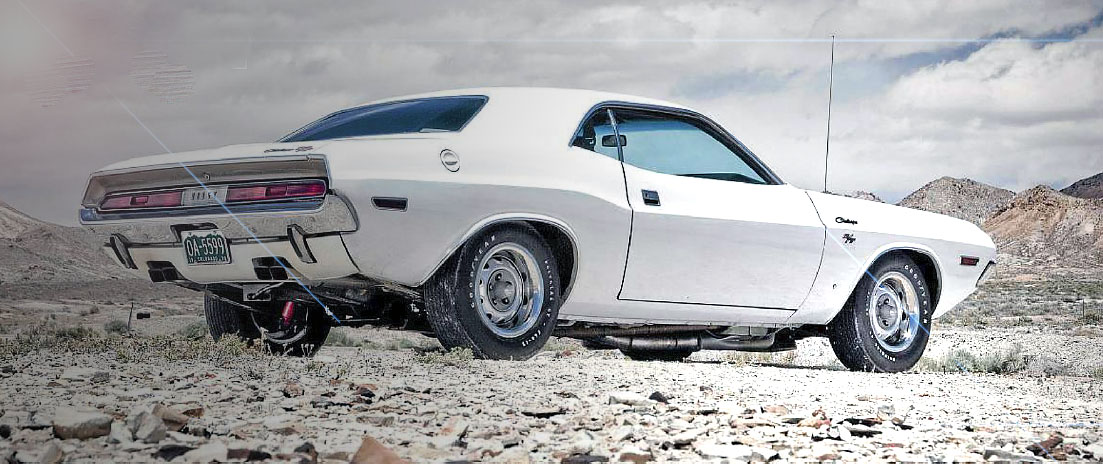
“It was ordained for the beginning, by Mr Zanuck at Fox, that Barry Newman was to play Kowalski,” says Serafian. He never specifically says why, but alludes to mafia influence over the studio. Newman wasn’t at all a bad choice – trim, blue-eyed and handsome, he exuded something of a darker-haired McQueen vibe. Serafian suggested and presented Gene Hackman for the role, only to be summarily discouraged.
The director adds that the use of Dodge’s new muscle car was also a forgone conclusion. And why not! The Challenger was as good an American mile-eater as anything else available at the time, and Serafian explains that the studio had a “dollar-a-day per car rental arrangement” with Chrysler.
Vanishing Point fanatics, Mopar anoraks, and chat room ‘experts’ don’t quite agree on the number and specification of cars used and used up in the film. The most common opinion is that five different cars were employed during filming, four of them 440 Magnum four-speed cars, and one running a 383 automatic. Serafian refers to the use of eight cars, claiming that all but one were destroyed in the process. One example, owned by Stephens Performance Collection, is claimed to be the number two stunt car, likely the ‘beauty car’ used by the primary production team in still shots or with Newman at the wheel.

As the script called for all manner of automotive mayhem, Serafian brought in Carey Loftin, the acknowledged king of stunt driving and coordination in America at the time. Loftin could make cars fly and land with precision; his timing and car control expertise were well demonstrated in Bullitt. Another Bullitt production vet was race car builder and driver Max Balchowsky. Known for building and racing a series of American V8 powered sports cars dubbed ‘Old Yeller’, Balchowsky extensively modified and reinforced the suspensions and chassis of the Mustangs and Chargers used in Bullitt, but performed very little mod work on the Challengers cued up for Vanishing Point. Most of his efforts took the form of repairing damage incurred during filming, and keeping the cars running and in one piece, often borrowing pieces from one to bandage another.
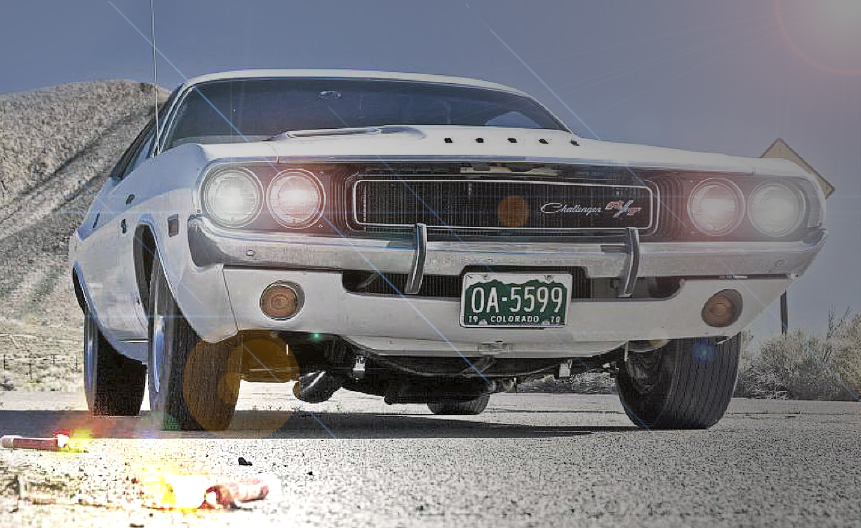
Another very important cast member is a young Cleavon Little, in his first major movie performance. Little, whom Serafian claims to have discovered on Broadway, plays Super Soul, a blind clairvoyant Dj who becomes Kowalski’s muse, and communicates with him through the airwaves and some ‘higher’ form of ESP. Serafian dubs them soul mates, who connected through the cosmos long before the notions of mobile phones or texting.
Super Soul refers to the police as “the blue meanies” chasing Kowalski at speeds through the desert from town to town.
Kowalski picks up the Challenger, plus a load of uppers, in Colorado and bets the dealer he can get from Colorado to San Francisco in 15 hours, which underpins and gives purpose to the mad cross-country chase. Serafian originally intended to end the film in San Francisco, somewhat reversing the notion of Bullitt’s iconic chase scene by having cars race up the hills of the City by the Bay, rather than down. But after a visit, he and the production team didn’t sense a warm welcome there, and weren’t sure they could do the stunts and chase scenes that they wanted to. So they elected to bring the chase, and thus Kowalski’s life, to an end in Cisco, California, a mostly abandoned town north west of Lake Tahoe.
To photograph and drive Steve Foster’s ’70 Challenger R/T in the right environment, we travelled to Goldfield, Nevada, a dusty mining town that wasn’t on Kowalski’s fateful route west, but that figured large in Vanishing Point as the home of radio station KOW and thus Super Soul’s soulful broadcast and the site of a vicious, bigoted attack on Soul and his (also African-American) engineer. According to Virginia Ridgeway, the city historian who runs Goldfield, it was home to more than 30,000 people during the heyday of the gold rush, and is now populated by 250 ‘characters’. When the multi-storey, concrete-and-brick Coldfield Hotel was built around 1910, it was quite the lavish joint, clearly the town jewel. By the time Serafian and company came to town, it had been closed for years and sat abandoned. The production crew built up Super soul’s studio in a portion of the ground-floor lobby.

The Challenger, an all-new model for 1970, was developed as Dodge’s cousin to the Plymouth Barracuda, itself fully redesigned and re-engineered the same year. A wide variety of powerplants were offered. Although Kowalski’s car was allegedly supercharged, the stock single-carb 440 Magnum big-block was good for 375 horsepower. Going up the line, there were two juicer offerings: the 440 Six-Pack, running three two-barrel carburettors (rated at 390 horsepower), and the almighty 426 Hemi, good for 425 ponies. Kowalski’s car was equipped with the iconic Hurst ‘pistol grip’ shifter stirring the four-speed manual transmission. The chassis was typical Mopar for the day: torsion bars up front, with a live axle and leaf springs in the rear. The movie cars ran unmodified disc-brakes up front, with drums out back, and steel, ventilated Dodge Rally wheels.
Foster’s car wasn’t born a 440-powered R/T, but it has been transformed into one (and then some). The visual morphing is quite effective, with the proper hood, badges, and quad rectangular tipped exhaust system all present and accounted for. Under the hood is a massively warmed-over 440 running aluminium heads. It twisted the dyno hard, spooling out more than 600 horsepower at the flywheel, and is backed by a Tremec five-speed manual transmission; not that the factory four-speed wouldn’t handle the horsepower, but the overdrive fifth gear allows for a relatively stout rear end ratio and relaxed freeway cruising.
Foster’s husky 440 runs a large single four- barrel carb and keeps cool via a massive aluminium radiator. A semi-aggressive camshaft means a lumpy idle, instant throttle response, and a symphonic exhaust rumble (all brass with lots of tenor and bass). Although Goldfield sits at nearly 6000ft above sea level, the big motor never burped, fouled a spark plug, or otherwise missed a beat during our dusty drive. The 50/50 mix of racing gas and pump-spec premium unleaded fuel probably helped.
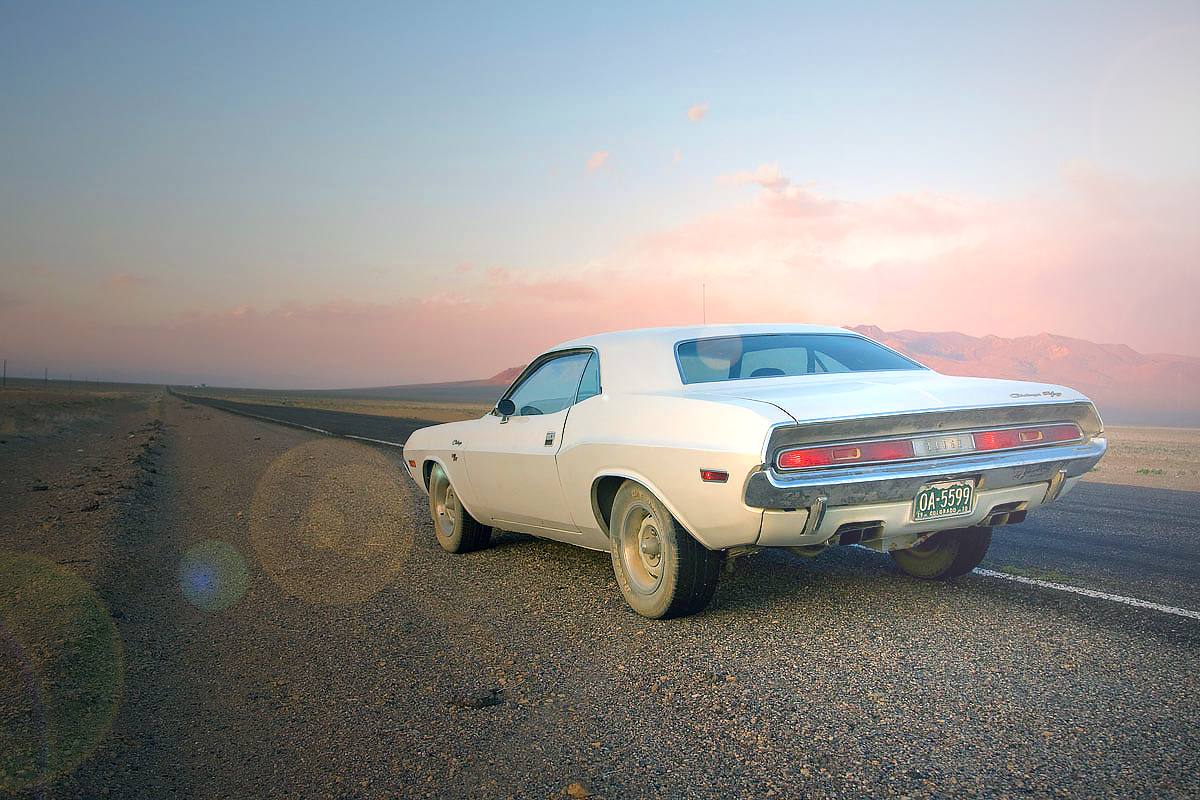
To preserve the car’s period look and some of its feel, Foster most often runs a set of reproduction F60-15 bias-ply tyres (he has another set of factory rally wheels wrapped by Pirelli speed-rated radials when he feels like driving friskier). Hotchkiss has upgraded the Challenger’s suspension with massive anti-roll bars, modern, high tech shocks, and fresh bushings. “It’s all the stock stuff,” comments Foster, but “just beefed up and fresh, for better handling and control.”

There is some ride penalty due to the stiffer underpinnings, but even those racy bits don’t completely compensate for the old tech rubber’s squishy nature. There’s amazingly little grip offered by the bias-ply tyres, so it’s no wonder Loftin and Newman (the actor drove some of the film’s stunts himself, doing several of its many burnouts) tossed the car around and spun it on a dime so easily and often. Brakes? Not bad. Purely old school musclecar, but not unsafe for today’s roads or modern driving conditions.
Foster’s is the fastest, best-handling classic Challenger we’ve even driven. Although stockers aren’t nearly this fast nor do they handle this well, it’s easy to understand why the original is such a musclecar classic, as its basic goodness shines through. The well- proportioned, neatly tapered, long-hood, short-deck style absolutely holds up, so much so that Chrysler reinterpreted it a few years ago and put the model back into production.
Authentically restored, big-engined examples bring big bucks, although the waters have calmed a bit since the musclecar lunacy price wars of 2006-7. Stop agonising over Hemis; a well-tuned 440 Six-Pack is just as quick, and the single-carb 440 Magnum holds its head up high, as does the high-winding 340 T/A.
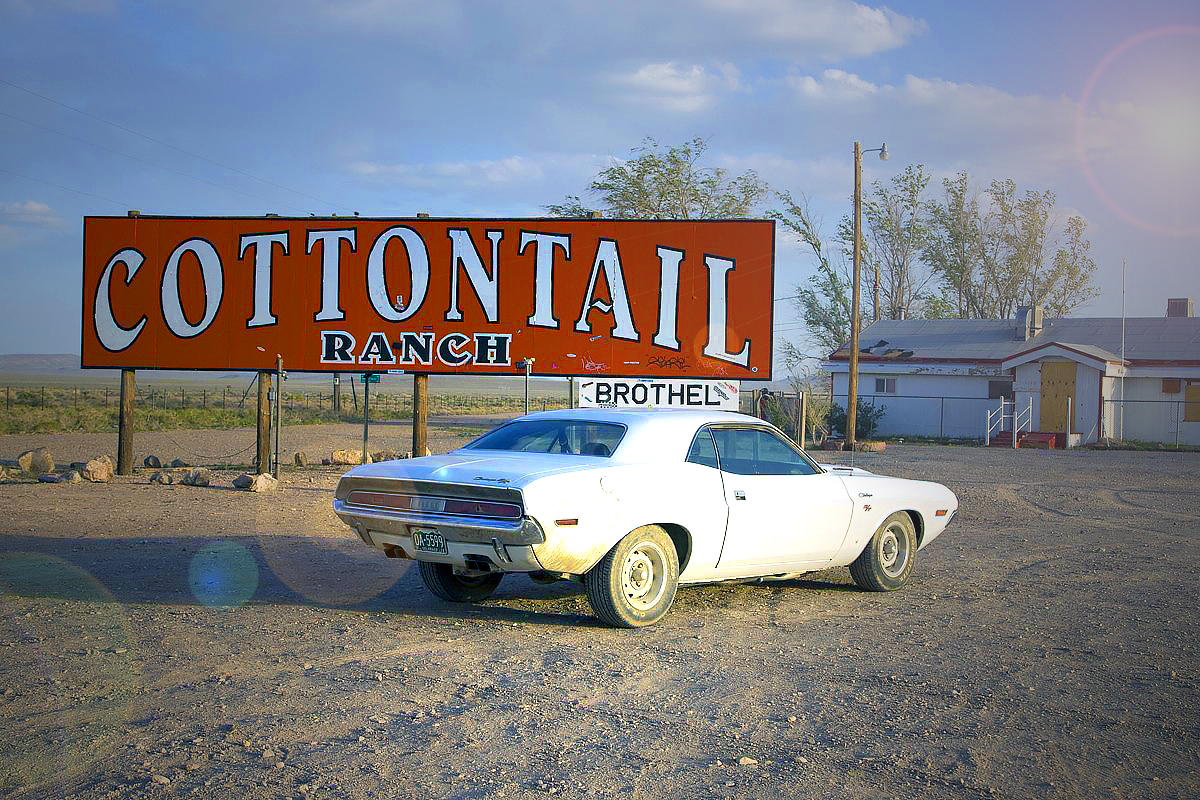
Vanishing Point holds up too, in a kitschy kind of way, especially when absorbed in context of the flower-powered era of its creation. The film has a well defined beginning, and a well known and highly defined ending, but in between these points of demarcation, the plot is really an obstacle course through which the protagonists must navigate. You’ll see it as a wonderfully crazy romp through time, the deserts of the great southwest, and a unique point in history. If you love cult car movies, action and stunt work, plus the destruction of countless old police cars, buy the DVD and crank up the surround sound. You won’t regret it.
Every gearhead’s favourite film star, a 1970 Dodge Challenger.
Behind the bulldozer
The question is not ‘when he’s gonna’ stop, but who is gonna ’stop him?’ and other Vanishing Point trivia…
The ‘Challenger’ that crashes into the two bulldozers at the end of Vanishing Point was actually a 1967 Camaro (look for the upside down Camaro badge as townsfolk inspect the wreckage). Stunt driver Carey Loftin towed it up to speed using the automatic-equipped 383 Challenger and the crew detonated explosives inside the Camaro just before impact.
Model and actress Charlotte Rampling had a role as a fog- shrouded hitchhiker who Kowalski picks up near the film’s end, but her scenes were deleted from the movie’s US release. “She was the allegorical vision of death,” Barry Newman says. “I couldn’t believe Fox execs cut her out – I thought they were some of the most important scenes in the picture.” Rampling did appear in the European versions of the film: her scenes are included on the flip side of the Vanishing Point DVD.
The Challenger’s Colorado licence, OA 5599, is highly prized by VP fans as a vanity plate.
While driving alone in a camera-rigged Challenger on a highway closed by police, Newman almost had a head-on collision with a motorist who managed to slip through traffic control.
Among the group of spiritual “J. Hovah” singers Kowalski encounters in the desert are David Gates (member of soft-rock band Bread) and Rita Coolidge. The movie also features some of the first songs recorded by Kim ‘Bette Davis Eyes’ Carnes.
Vanishing Point is allegedly based on a true story of a California youth who led police on an extended chase before crashing to his death.
Ask the man who owns one – owner Steve Foster
Steve Foster is a retired California Highway Patrol officer living in South Orange County, California. An avid painter, he now creates and deals in automotive fine art and apparel.
Why I like it: “It’s a body style I never grow tired of looking at. It’s fast and fun to drive, and it’s an interesting contrast to my Ferraris and Alfas.”
Why it’s collectible: Vanishing Point is a classic flick, and a white R/T 440 was the star.
Restoring/maintaining: These are straightforward, tough, honest, easy cars to fix, modify and maintain. And everything is available for it and to its cousin the Barracuda.
Beware: Don’t overpay for a car that began life with a 318 under the hood and has been cloned up into something else. And, obviously, there’s no reason to buy a car that’s been crashed hard and fixed. Move on to something else.
Expect to pay (coupe) Concours ready: $61,974. Solid driver: $32,625. Tired runner $19,575.
Join the club: Dodge Challenger Forums and Owners Club challengerforumz.com, Walter P Chrysler Club – chryslerclub.org
What the experts say:
Then: Okay, so the car isn’t made for city driving; get it out on the open road – AB Shuman, reporting on an architecturally and mechanically similar Plymouth ’Cuda equipped with 440 Six-Pack, four speed transmission, manual steering, and manual all-drum brakes. Motor Trend, May 1970
Now: The original Challenger was so cool they brought it back. The new one is awesome and the old one holds water even now. Motor Trend.
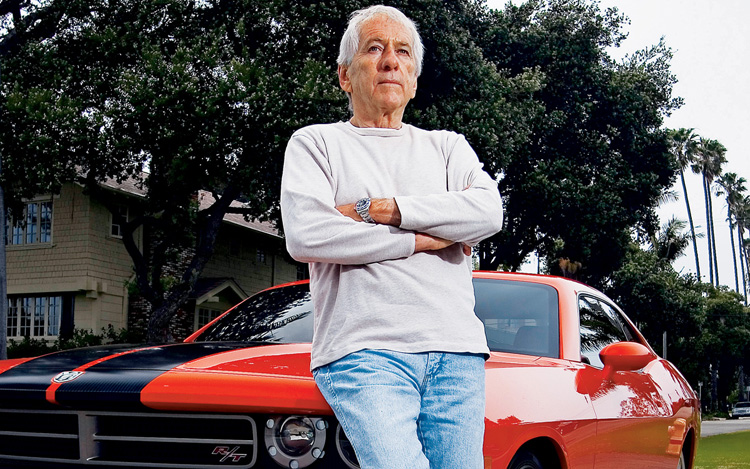
Kowalski – the Barry Newman today.
The last American hero, the electric centaur, the demi-god, the super driver of the golden west! Actor Barry Newman, Kowalski himself, reflects of Challengers old and new – and on the movie that made him a cult icon.
“Vanishing Point is an existentialist film,” says Newman, now 73. “When I read the script, I said to my agent, ‘this is amazing. It’s not just a car chase picture. You gotta understand this’.” When it was released in 1971, American audiences at first didn’t get it. “But the picture was a smash in Europe,” Newman says. “Biggest critical and box office success of the year. So 20th Century Fox re-released it in America as a double bill with The French Connection. And then it took off.” Ever since, Newman – who went on to star in the Seventies TV series Petrocelli and such films as The Limey – has been synonymous with Kowalski. “People still pull up next to me and say ‘Hey! Vanishing Point guy!’”
Newman remembers the original Challengers fondly. “They had so much power, almost too much for the body. You’d put it in first and stand on the L gas, and it would almost rear up.”
Though he did much of the driving in the movie and even learned to do his own spinouts, Newman says all the movie’s impressive stunts were performed by Hollywood legend Carey Loftin. “Carey was fantastic. They’d say, ‘Carey, can you roll this car four times and end up right here?’ And he’d just stare back and say ‘yep’.”
Before we bid adieu, Newman shares a unique insight into the explosive ending of Vanishing Point.
“Kowalski wasn’t committing suicide,” Newman says. “He sees that glint of light, that crack between the two bulldozer blades, and that’s why he’s smiling at the end. The audience may know Kowalski’s going to die, but he’s smiling ’cause he thinks he’s going to make it. In a sense, he sees a way through.” Arthur St Antoine.





